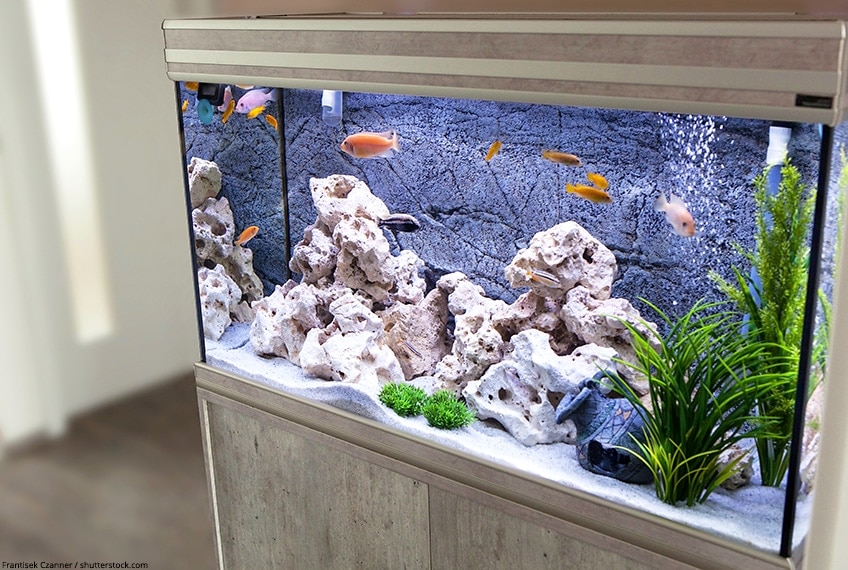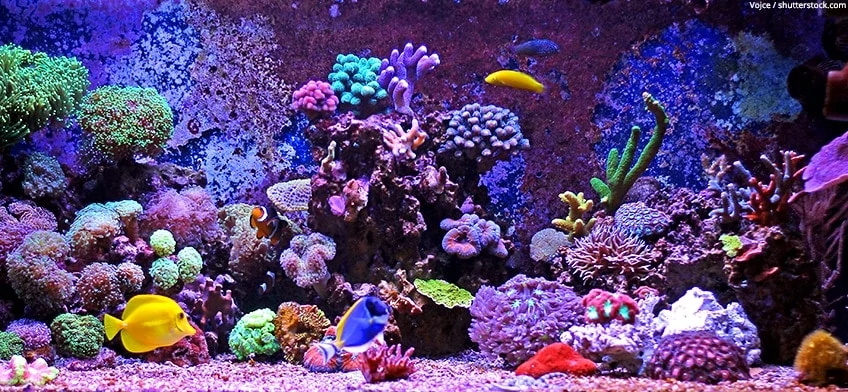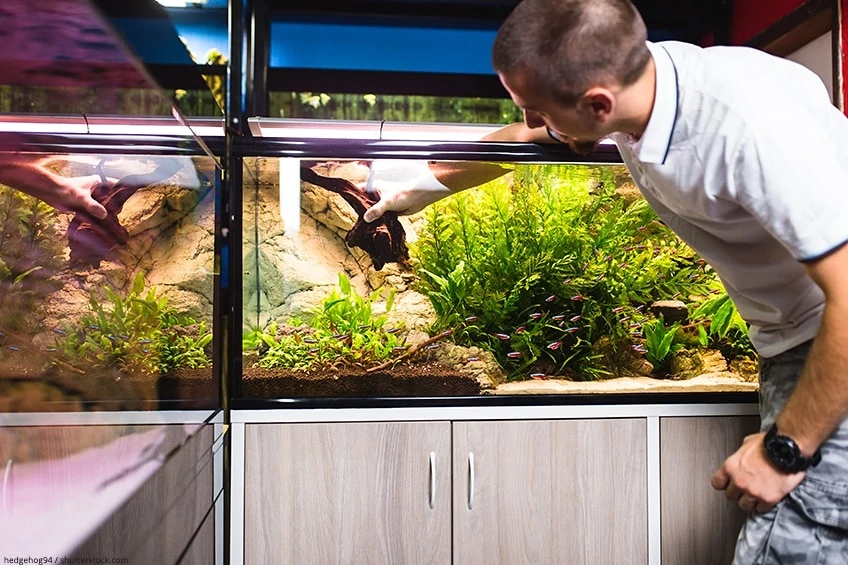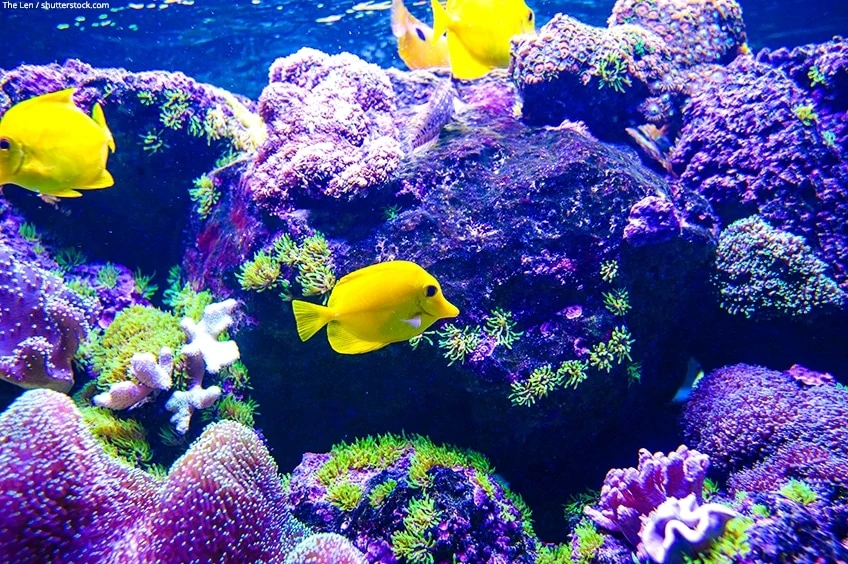How To Waterproof Aquarium Decorations
Aquarium Safe Epoxy – Learn how to use Resin for your Aquarium

If you would like to do something good for your fish and offer them a little variety, try a mural fabricated of polystyrene and epoxy resin in the aquarium. With a little skill and the right epoxy resin for your aquarium, you lot tin can turn your ideas into reality in no time at all and even protect the underwater world from signs of habiliment and tear. How this works and what yous need to consider when using epoxy resin in aquariums is explained in our guide.
Inhaltsverzeichnis
- 1 Applications of epoxy resin in the aquarium
- 2 Advantages of sealing with epoxy resin in aquarium construction
- 3 The suitable epoxy resin
- 4 These materials in the aquarium tin be sealed
- five Instructions for the sealing of objects in the aquarium
- 5.ane Mix epoxy resin
- five.2 Utilize past brush
- 5.three Discover curing time
- 6 Safety instructions for working with epoxy resin
Applications of epoxy resin in the aquarium
Epoxy resin not only plays a representative role in the aquarium by being used for the creation of impressive landscapes. It can do much more:
- Epoxy resin in the aquarium effectively seals all surfaces and makes them waterproof
- With a combination of polystyrene and epoxy resin, you lot can create not only varied landscapes for the aquatic life in the aquarium, but also modest caves and stone formations as refuges on the dorsum wall
- Epoxy tin can besides exist used to glue different parts together
- Even shiny waterfalls tin can be modelled with information technology
- You can also make complete surfaces very interesting by sprinkling coarse sand, gravel or quartz stones onto the still wet epoxy resin.

Advantages of sealing with epoxy resin in aquarium construction
- The health of your fish and other aquarium inhabitants should be protected. Sometimes unsafe leaner nest in the water and endanger the fish population. Then the aquarium must be cleaned laboriously. However, epoxy resin protects the sealed surfaces from potential pathogens. Information technology massively improves the water quality past keeping harmful influences away.
- Even the moisture that would normally assault the pattern elements afterwards some time can exist finer combated in the aquarium by sealing with epoxy resin. Used correctly, epoxy protects all surfaces from the cool moisture.
- Moss has no chance confronting epoxy in the aquarium – information technology keeps all surfaces sealed with it complimentary of unwanted plants. This is a slap-up advantage for the possessor of the aquarium, as he does non accept to clean it extensively.
- Some other advantage is the high UV resistance of the epoxy resin. Peculiarly if your aquarium is located in a particularly light-flooded room, it is an reward to protect the surfaces with a suitable agent. This can be epoxy, equally it keeps harmful UV rays away from the sealed surfaces.
- Furthermore, epoxy is not simply scratch-resistant, only too impact-resistant and resistant to all animate being excrements and is therefore ideally suited to withstand loftier loads. The surface of the hardened epoxy resin is completely smooth and can therefore exist hands disinfected or cleaned if necessary.
- The concluding large advantage is the compatibility with diverse additives such as fillers and colorants, because with the help of these you tin create the well-nigh diverse landscapes the way the user wants them. Whether you want to grade a smooth or a seemingly moss-covered rock face, dark stones or light chalk cliffs or possibly even one or the other statue – everything is possible with the correct epoxy resin for the aquarium, some styrofoam and a skillful manus.
The suitable epoxy resin
Special terrarium resins are offered, which are perfectly suited for sealing surfaces. They are also a adept choice for the aquarium.
However, they are much more expensive than the common laminating resins. All the same, they are completely sufficient for sealing in the aquarium, because cured they not only have all the positive properties of a terrarium resin, but are also non-toxic. They do non emit any harmful substances that could harm aquatic life in any way.
You can therefore hands use a commercially available laminating resin, which tin be practical with a castor:

- High-quality starter gear up for Resin Fine art
- Thicker constistency, 1:1 mixing ration for easy use
- 45 minutes of working time untill it starts to get pasty, almost no yellowing
View on Amazon
These materials in the aquarium can be sealed
In principle, epoxy is suitable for all conceivable materials. Yet, the user tin can benefit from epoxy resin on polystyrene when building an aquarium. Styrofoam tin be easily modelled, coloured and then sealed with epoxy resin. The epoxy resin does non attack the styrofoam and information technology keeps its shape.
But other materials tin too be sealed with epoxy resin. For example, the resin is too ideal for sealing wood. In this case, yet, yous should pay attention to the consistency of the epoxy used, as information technology is bachelor in both thin and thick-bodied versions. Your choice depends on the material to be sealed. If this is porous, an epoxy system with a high penetration strength should exist called. Medium and high viscosity epoxy resin systems, on the other mitt, are especially suitable for smooth surfaces.
Apart from that, epoxy is in principle an all-rounder, which unfolds its positive properties on nearly all materials.

Instructions for the sealing of objects in the aquarium
Sealing objects with epoxy resin for the aquarium is not witchcraft. Even if yous are a rather inexperienced craftsman, y'all will succeed with our pace-by-step instructions.
Mix epoxy resin
First you have to mix the epoxy resin co-ordinate to the bundle insert. Brand sure that the correct mixing ratio of resin and hardener is used. If this is not observed, the curing may be insufficient. The resin volition remain sticky and cannot develop its positive properties; in addition, harmful substances may be released. Epoxy is only harmless when fully cured.
Put the resin and hardener in a big container and stir thoroughly. If necessary, you tin repot the mixture and stir again to make a especially thorough mixture. Recall to brush along the edge and bottom of the container several times to ensure that the two components are perfectly mixed.
After mixing, the and then-called pot life begins. Now y'all should work quickly, because this is limited. Afterwards the epoxy resin is hardened and cannot be candy further. In example of doubt you should always mix only a little epoxy and later on, if necessary, more of it. The cooler the room in which you work, the longer the pot life.
Apply by brush
At present apply the epoxy resin with a brush to the surfaces to be treated. These can be dissimilar stone formations or objects for the aquarium, simply also flat structures or a back wall. These were previously modelled from polystyrene and coated with tile adhesive to create lifelike landscapes or objects.
When sealing with epoxy resin, make sure to apply a thin layer to avert unsightly lumps on the surface. However, each area should be thoroughly coated with the resin to ensure that the sealant is applied correctly. This is followed by the curing stage.
Observe curing time
Once the epoxy resin is fully cured, it no longer releases any harmful substances. Still, the deviation between the drying phase and the curing phase is important. The latter takes considerably longer. But when this has been observed should the surfaces sealed with epoxy resin be used in an aquarium. It is best to follow the manufacturer's instructions.
Please note that the curing time can vary considerably depending on the ambient temperature and humidity. If in doubt, it is amend to requite the epoxy resin a little more time – the health of your fish volition give thanks you.

Safety instructions for working with epoxy resin
When working with epoxy resin, dispensable gloves as well as a animate mask and, if necessary, prophylactic goggles must be worn. Ensure that the workplace is adequately ventilated or work outdoors. Long-sleeved clothing is also recommended. Open fire is to be avoided at all costs!
Should the resin come up into contact with your skin, wash information technology off immediately and thoroughly with warm water. In case of contact with your mucous membranes or your eyes, consult a doctor immediately! Take the packet insert with y'all so that he tin can get an thought of the ingredients.
The design of an aquarium is not simply suitable for professionals, but likewise for untrained craftsmen who only enjoy modelling. Your aquatic inhabitants will certainly enjoy their new landscape with epoxy resin on styrofoam.
How To Waterproof Aquarium Decorations,
Source: https://resin-expert.com/en/guide/aquarium-safe-epoxy
Posted by: herrerarialf1948.blogspot.com


0 Response to "How To Waterproof Aquarium Decorations"
Post a Comment